January’s freezes led to some interesting resaca happenings. This particular tale happened to a friend who lives on a resaca near Bayview.
After the first January freeze, frozen fish popped up to the water’s surface and drifted to the edge of the resaca where he could scoop them out and examine.
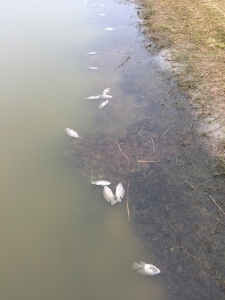
Some of the fish were identified as Mozambique tilapia — the white spots on the rear caudal fin and reddish tail fin help ID this particular fish.
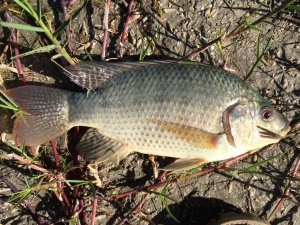
Another species of tilapia was tentatively identified as either blue or Nile tilapia.
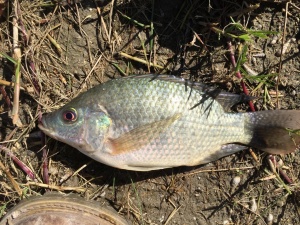
His cats had no interest, but as the day progressed, turkey and black vultures and crested caracara began arriving by the numbers to the killing field.
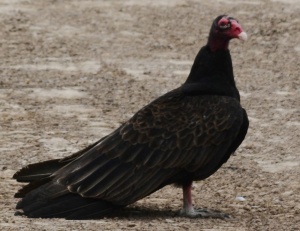
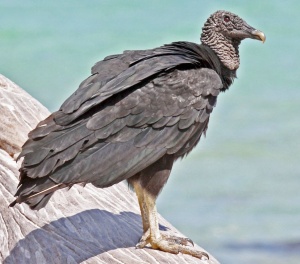
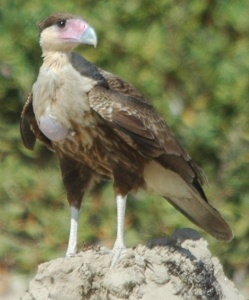
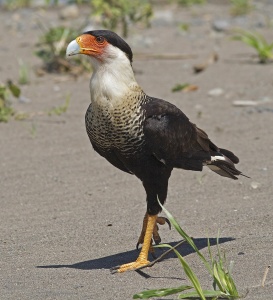
It’s not unusual for caracara to scavenge with vultures. Turkey vultures have an incredibly keen sense of smell — better than black vultures that often follow turkey vultures around. Caracaras come in third, and although the smallest of the three, often dominate the scene once they arrive at a carrion.
See Nov. 28, 2016, blog post, “The Vultures are Back” for more about turkey vultures. https://rgvctmn.org/2016/11/
On the one hand, it’s amazing how the universe is designed to the nth degree. The end of the nth, in this case, being the clean-up detail for a massive fish kill.
On the other hand, my friend — who has a passion for palms, tending more than a dozen species on his acreage, including the beautiful Bismarck, coconut, Cuban royals, Everglades, reclinata, lady palms and queens, along with several of the ubiquitous Washingtonians — was not prepared to host hordes of huge birds when suddenly, his big, beautiful green palm fronds turned into an impromptu, although excellent, B&B.
Currently, his palms serve as home to colorful oriels, a great horned owl, Eastern screech and barn owls, and a belfry of Mexican yellow bats.
As the light faded from the sky each evening, a looming of vultures and a cast of caracaras eyed my friend as the birds settled in for the night. (Refer to previous blog post on collective bird nouns https://rgvctmn.org/anitas-blog-the-boringness-of-flocks/
The vultures chose the tallest Washingtonians and the caracaras, considered a tropical falcon version of the vulture, chose to bed elsewhere.
One to observe and, indeed, marvel at all nature throws his way, my friend was rather delighted to witness this intense enterprise of nature’s “sweepers” — until mid-week, when he once more awoke to a winter-wonder-land of white-drenched palm fronds. This time, it wasn’t snow, it was bird poop. Tons of bird poop.
Now, for someone taking pride in his acres of palms, he could only shake his head and began his daily chores. After all, for one who uses a rainwater catchment system, how does one wash the fronds of a 35-foot tall Washingtonian and the myriad plants beneath, robellini and date palms and hibiscus?
While researching for this post, I read on the Internet that birds poop on takeoff to rid themselves of excess weight — sort of opposite to airplanes discharging excess fuel prior to landing — just a little sidebar of unusual information, here. Landing produces stress to an aircraft; the lighter the load upon landing, the less chance of damage to the craft. Conversely, in a feathered bird, the theory is that a lighter weight produces a more energy-efficient flight.
Meanwhile, back on shore, it took a week for the detritus of dead fish to be cleaned up; the well-fed opportunists fled the scene, onto richer fields of carrion carcasses.
Then, several things happened. Another cold front blew in on a nasty north wind. The power went out for nearly 24 hours in parts of the Lower Valley. Icy rain drenched the land and everything on it. After sunrise the next day, the Valley temperatures finally began to rise above freezing. The white residue, left by the feathered marauders, drained from the palm fronds, leaving my friend with free, fancy fertilizer for payment in return for his generous and elite accommodations.
Interestingly enough, white bird poop is excellent fertilizer. It contains phosphorus and other nutrients, making it highly beneficial to a garden. Phosphorus is noted especially for its role in capturing and converting the sun’s energy into useful plant compounds.
It helps stimulate root development, increase stalk and stem strength and increase resistance to plant diseases.
Phosphorus, of course, is one of the main three nutrients most commonly found in fertilizers and is the “P” in the NPK balance that is listed on fertilizers.
I am learning so much about our valley nature from your delightful blog! Thank you!
Thank you, Erin! I appreciate your taking the time to tell me. Writing the blog is a fun way for me to learn, too!